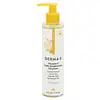What's inside
What's inside
 Key Ingredients
Key Ingredients

 Benefits
Benefits

 Concerns
Concerns

 Ingredients Side-by-side
Ingredients Side-by-side

Water
Skin ConditioningSodium Methyl Cocoyl Taurate
CleansingCocamidopropyl Hydroxysultaine
CleansingGlyceryl Laurate
EmollientDisodium Laureth Sulfosuccinate
CleansingCocamidopropyl Betaine
CleansingNiacinamide
SmoothingPanthenol
Skin ConditioningGlycolic Acid
BufferingGlycyrrhiza Glabra Root Extract
BleachingAscorbyl Palmitate
AntioxidantArctostaphylos Uva Ursi Leaf Extract
Skin ConditioningLilium Candidum Leaf Cell Extract
Skin ConditioningCamellia Sinensis Leaf Extract
AntimicrobialRetinyl Palmitate
Skin ConditioningAllantoin
Skin ConditioningCitrus Aurantium Dulcis Oil
MaskingPotassium Sorbate
PreservativePhenoxyethanol
PreservativeEthylhexylglycerin
Skin ConditioningWater, Sodium Methyl Cocoyl Taurate, Cocamidopropyl Hydroxysultaine, Glyceryl Laurate, Disodium Laureth Sulfosuccinate, Cocamidopropyl Betaine, Niacinamide, Panthenol, Glycolic Acid, Glycyrrhiza Glabra Root Extract, Ascorbyl Palmitate, Arctostaphylos Uva Ursi Leaf Extract, Lilium Candidum Leaf Cell Extract, Camellia Sinensis Leaf Extract, Retinyl Palmitate, Allantoin, Citrus Aurantium Dulcis Oil, Potassium Sorbate, Phenoxyethanol, Ethylhexylglycerin
Water
Skin ConditioningCocamidopropyl Hydroxysultaine
CleansingGlycerin
HumectantSodium Lauroyl Sarcosinate
CleansingPEG-150 Pentaerythrityl Tetrastearate
EmulsifyingNiacinamide
SmoothingPEG-6 Caprylic/Capric Glycerides
EmulsifyingSodium Methyl Cocoyl Taurate
CleansingPropylene Glycol
HumectantCeramide NP
Skin ConditioningCeramide AP
Skin ConditioningCeramide EOP
Skin ConditioningCarbomer
Emulsion StabilisingMethylparaben
PreservativeSodium Chloride
MaskingSodium Lauroyl Lactylate
EmulsifyingCholesterol
EmollientDisodium EDTA
Propylparaben
PreservativeCitric Acid
BufferingTetrasodium EDTA
Hydrolyzed Hyaluronic Acid
HumectantPhytosphingosine
Skin ConditioningXanthan Gum
EmulsifyingWater, Cocamidopropyl Hydroxysultaine, Glycerin, Sodium Lauroyl Sarcosinate, PEG-150 Pentaerythrityl Tetrastearate, Niacinamide, PEG-6 Caprylic/Capric Glycerides, Sodium Methyl Cocoyl Taurate, Propylene Glycol, Ceramide NP, Ceramide AP, Ceramide EOP, Carbomer, Methylparaben, Sodium Chloride, Sodium Lauroyl Lactylate, Cholesterol, Disodium EDTA, Propylparaben, Citric Acid, Tetrasodium EDTA, Hydrolyzed Hyaluronic Acid, Phytosphingosine, Xanthan Gum
 Reviews
Reviews

Ingredients Explained
These ingredients are found in both products.
Ingredients higher up in an ingredient list are typically present in a larger amount.
Cocamidopropyl Hydroxysultaine is a synthetic cleansing agent, though it is derived from coconut oil.
It is used to enhance the texture of products by boosting lather and thickening the texture. As a cleanser, Cocamidopropyl Hydroxysultaine is mild.
Niacinamide is a multitasking form of vitamin B3 that strengthens the skin barrier, reduces pores and dark spots, regulates oil, and improves signs of aging.
And the best part? It's gentle and well-tolerated by most skin types, including sensitive and reactive skin.
You might have heard of "niacin flush", or the reddening of skin that causes itchiness. Niacinamide has not been found to cause this.
In very rare cases, some individuals may not be able to tolerate niacinamide at all or experience an allergic reaction to it.
If you are experiencing flaking, irritation, and dryness with this ingredient, be sure to double check all your products as this ingredient can be found in all categories of skincare.
When incorporating niacinamide into your routine, look out for concentration amounts. Typically, 5% niacinamide provides benefits such as fading dark spots. However, if you have sensitive skin, it is better to begin with a smaller concentration.
When you apply niacinamide to your skin, your body converts it into nicotinamide adenine dinucleotide (NAD). NAD is an essential coenzyme that is already found in your cells as "fuel" and powers countless biological processes.
In your skin, NAD helps repair cell damage, produce new healthy cells, support collagen production, strengthen the skin barrier, and fight environmental stressors (like UV and pollution).
Our natural NAD levels start to decline with age, leading to slower skin repair, visible aging, and a weaker skin barrier. By providing your skin niacinamide, you're recharging your skin's NAD levels. This leads to stronger, healthier, and younger looking skin.
Another name for vitamin B3 is nicotinamide. This vitamin is water-soluble and our bodies don't store it. We obtain Vitamin B3 from either food or skincare. Meat, fish, wheat, yeast, and leafy greens contain vitamin B3.
The type of niacinamide used in skincare is synthetically created.
Learn more about NiacinamideThis gentle cleansing and foaming ingredient is known for leaving a smooth feeling in skin and hair. It is made using coconut oil.
According to the manufacturer, it is soluble in water and has resistance to hard water, acid, and alkali.
Due to its coconut base, it may not be Malassezia folliculitis safe.
Learn more about Sodium Methyl Cocoyl TaurateWater. It's the most common cosmetic ingredient of all. You'll usually see it at the top of ingredient lists, meaning that it makes up the largest part of the product.
So why is it so popular? Water most often acts as a solvent - this means that it helps dissolve other ingredients into the formulation.
You'll also recognize water as that liquid we all need to stay alive. If you see this, drink a glass of water. Stay hydrated!
Learn more about Water